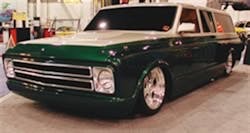Light trucks have come a long way. No longer are they solely workhorses, to be hammered, dented and dinged and tossed out to pasture after a useful utilitarian life.
Today´s owners of trucks and SUVs can have as much fun with their glistening wagons as the sports car, luxury car and tuner car folks. For example, today´s expanding wheel market offers 17-, 18-, 19- and even 20-inch alloys for the truckster who wants to get all gussied up for daily driving and boulevard cruising. Tire profiles as low as 35 and even 30 series are available for many of these applications. And there are many other ways to accessorize these vehicles.
TIRES AND WHEELS
When a passenger car tire is fitted to a light truck, the rated load carrying capacity of the tire must be reduced. If you examine the vehicle´s tire placard and determine that passenger car tires were originally specified as original equipment on the vehicle, the vehicle manufacturer already has reduced the tire load to what appears on the placard. On the other hand, if the vehicle´s tire placard indicates that the vehicle´s original equipment fitment was a light truck (LT) tire, and the customer requests a passenger tire replacement, you must reduce the rated load shown on the tire sidewall by using the following formula:
Rated load divided by 1.1 = Reduced load for light trucks
This is approximately 91% of the tire´s rated load. For example, if the P-metric tire being considered is load rated for 2000 pounds at 41 psi, the new load rating for use on a light truck would be reduced to 1818 pounds at 41 psi:
2000 divided by 1.1 = 1818 at 41 psi.
Remember to reduce the passenger tire rated load before considering a passenger tire as a replacement for the original LT tire. If the vehicle came equipped with load range D or E LT tires, you may find it impossible or impractical to consider passenger tire replacements if they will not carry the vehicle load. If the considered P-metric tire´s revised load rating matches that required by the original LT tire´s load rating, the tire may be considered. If not, it would not be advisable to install that specific P-metric tire.
Whenever the customer plans to install larger diameter wheels and lower-profile tires, always make a point to consider tire load capabilities and suspension/body clearances issues.
[PAGEBREAK]
SUSPENSION
Any vehicle that is to be driven in a "sporty" manner (define that term as you wish) can benefit from an enhanced suspension, including cars, trucks, vans and sport utility vehicles. If you want to make your light truck or SUV more fun to drive, the aftermarket offers every conceivable part to get the job done.
Since many light truck and SUV owners wish to transform their beasties of burden into slammed and slick big-brother versions of tuner cars, lowering kits and large-diameter wheels mated with slab-profiled tires are the order of the day. A word of caution: When altering ride height more than one inch or so, don´t blindly slap on a set of shorter springs and expect everything to work properly. Always consider the effect these changes will have on wheel geometry and clearances. Depending on vehicle suspension design, lowering the vehicle may adversely effect camber, cast and the scrub radius.
Also, if the vehicle is lowered excessively, the shock absorbers may run out of compression travel, causing them to run on their bump-stops. In this case, shocks may require relocation or replacement with shorter shocks. Simply be aware of the after-effects of a substantial lowering job. This is one reason to stick with experienced aftermarket suspension firms that can advise you on the creation of a "system" approach that will allow the suspension to function properly.
With that said, if the truck or SUV owner desires a reduction in ride height (naturally we´re referring to street-smart truckies that will never traverse off-pavement), several options are available to get the job done. Shorter coil springs, where applicable, allow a relatively easy one- to three-inch drop.
Another mode suitable for rear-drive buggies involves the installation of drop-spindles, which simply relocate the wheel center higher relative to the lower ball joint, for a quick two- or three-inch drop.
A combination of drop spindle and shorter coils can also be used. For vehicles that feature upper and lower A-arms and coil springs, when a drop is created, this can easily affect the scrub line clearance. The answer is to install a complete kit that includes new upper and lower arms with altered lengths, which correct the spring and ball joint angles back to stock specification. These corrections result in factory geometry, with the ability to easily retain full factory camber and caster angles. This will allow you to maintain proper steering, handling, braking and tire wear characteristics.
For trucks that feature I-beam front suspension, aftermarket "drop" beams are available to overcome a normally difficult obstacle when the owner wishes to slam the front.
When dealing with front torsion bar suspensions, aftermarket lowering control arm kits are available that feature a re-engineered torsion bar receiver. For those hearty souls who want a severe drop with no holds barred, the truck frame can be notched in order to move the axle upward, closer to the body.
Naturally, this requires carefully planned cutting, fabricating and reboxing of the frame sections, but it´s a common task that any good chassis shop can handle.
Lowering the rear of a leaf-sprung vehicle often involves the use of a "flip" kit that allows relocating the rear axle above the spring package (for application where the OE spring is located above the axle).
[PAGEBREAK]
AIR SUSPENSIONS
An increasingly popular alternative to ride height modification involves the use of airbag suspension kits. An airbag, or airspring, is a heavy-duty doughnut or barrel shaped airbag constructed of rubber and a high-strength fabric. The airbag, sold complete with attached mounting hardware, is designed to replace a coil spring, or may replace or augment a rear leaf spring system. The shock absorber is still maintained with the use of an airbag.
The shock may be relocated, or may be assembled as part of the airbag spring. Air Ride Technologies, to cite an example, offers a "Shockwave" airbag system that features an adjustable shock and airbag assembly as a single installed unit.
Depending on vehicle weight, suspension design and airspring selection, an airbag system will generally provide as much as a three- to four-inch adjustment at the front and as much as a five- to six-inch adjustment at the rear. Typically, an airbag suspension is set to ride within two inches of the stock ride height.
The airbags are controlled via air pressure in order to adjust ride height and/or load requirements. An onboard electric air compressor is mounted in a convenient location, such as the rear seat area. An alternative to using an onboard electric air compressor is a rechargeable compressed nitrogen tank (these are available in various sizes) fitted with a regulator. Nitrogen tanks cannot be used without regulators, since these tanks are typically charged at 2,000 psi, and the airbag system requires only in the neighborhood of 100 psi. The best approach is to use the electric air compressor offered by the airbag supplier, since compressed nitrogen can be extremely dangerous in inexperienced hands.
Since an airbag suspension is, by its nature, adjustable in terms of ride height, front wheel alignment must be considered when installing the system. Always align the front wheels with the bags set at normal ride height (the height at which the vehicle will normally be operated). When parked, the system may, at the owner´s discretion, be "dropped" for a cool appearance at a show. While airbag suspensions may be operated with no air pressure, this is not advisable. Zero air pressure will result in poor ride quality and eventual chafing wear of the bag. Generally speaking, it´s best to run at least 20 psi in the system.
If the truck or SUV rear is equipped with rear leaf springs, an airbag system may be installed. For a vehicle that already provides a decent ride but needs ride height adjustment, it is normal practice to remove one or two leafs, allowing the truck to settle. The airspring is then installed between the spring and frame. For vehicles that need to be raised or require extra load capacity, the airspring may be installed with the OE leafs intact.
Airspring suspensions have become increasingly popular among a variety of vehicle niches, including street rods, fat-fendered hot rods, trucks, SUVs, muscle cars, tuner cars and "lowrider" cars and trucks. These systems work just fine, and are generally very reliable. The greatest benefit is their easy and immediate adjustability, with air pressure controlled from the driver location via a gauge-monitored control panel.
[PAGEBREAK]
ANTI-SWAY BARS
In most trucks and SUVs, the change to heftier anti-sway bars can certainly improve handling and stability and can reduce the amount of body roll relative to the chassis. As with bar upgrades on passenger cars, the move to thicker anti-sway bars will not degrade ride quality.
Moving to thicker bars also will greatly reduce the effects of body sway under heavy cross-wind conditions, and will make the vehicle more pleasant to operate when towing a trailer. Bar thickness will vary depending on the specific vehicle application, so always follow the recommendations of the bar manufacturer. But always install a matched pair of front/rear bars.
LIFT KIT BUSINESS
Here are three keys to success when selling and installing lift kits:
1. Make sure everyone knows their stuff, from installers to salespeople.
2. Price the entire service -- lift kit, installation, shocks, alignment, etc. -- as a competitive package.
3. Advertise your expertise and the brand names of the kits you stock.
Source: Truck & SUV Performance




